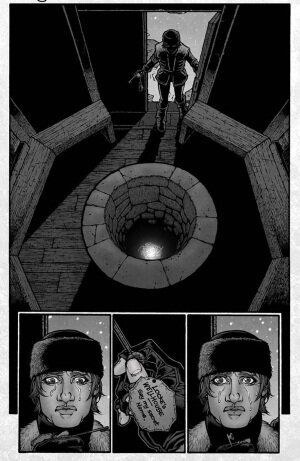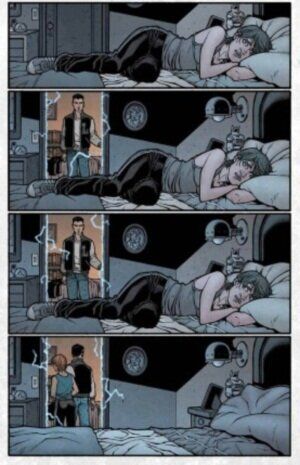The brain-child of Horns author Joe Hill, and the artist Gabriel Rodriguez, Locke and Key is an ongoing comic book fantasy-horror series produced by IDW Publishing. The premise of Locke and Key is both stunningly simple and wonderfully original. Following the death of their father, the surviving members of the Locke family return to their family home of Key House in the town of Lovecraft in Massachusetts. It is here that the Locke children, Tyler, Kinsey, and Bode, discover keys that unlock not only doors but supernatural abilities as well, and something - or someone - that wants the keys to unlock a very special door.
Each volume forLocke and Key is produced initially as a six-part monthly comic book, which is later collected into a single graphic novel. At the time of writing, four volumes within the series have been released and a fifth has recently completed its comic-book run. A sixth volume, yet to be titled, is expected to conclude the story later this year.

Volume 1: Welcome to Lovecraft
Following the murder of their father, the surviving members of the Locke family move to their ancestral home of Key House in Lovecraft to start a new life. Here, everything is not as it seems: keys unlock doors as well as abilities, and then there is that Echo.
Volume 2: Head Games
Following the events in the first volume, Echo is free, and a third key is found: the head key. We meet new people and new allies within Lovecraft Academy. The new key allows people to unlock their minds, with good and bad results, and Echo begins their plan to find the Omega Key.
Volume 3: Crown of Shadows
The threat posed by Echo is now fully understood, as the Shadow Key is found by Echo, and the Locke children take a stand in an epic confrontation. We also learn more of what happened in the past when the keys were used.
Volume 4: Keys to the Kingdom
Whereas before there were a handful of keys revealed in small doses, here we find a plethora of new keys. Echo takes the offensive using these new keys, and Tyler deduces Echo's identity at last.
Volume 5: Clockworks
The history of the Locke family is unveiled to Tyler and Kinsey, as they travel through time, and secrets beyond imagination are revealed. Meanwhile the evil of Echo reaches new levels as it seeks the ultimate prize of the Omega key.
Running in parallel with the storyline of Locke and Key are the events of 1985 when the keys were previously used by Rendell Locke and his friends for a production of Shakespeare's The Tempest. As the series progresses, we continue to learn more - through photos, dialogue, and cryptic messages - about how this back-story underpins the main storyline and was the instigator of the current events.
What strikes me most about Locke and Key is the stunning writing. Anyone who believes that the writing in comic-books and graphic novels is sub-par and "just for kids" needs to read this as a re-education in how to not believe urban-myths. Simply put, the writing is exquisite, where each and every character is a well-defined and rounded individual, written with a voice all of their own. It never feels as if Joe Hill is bowing down to stereotypes.

The central characters are of course the Locke children. The eldest, Tyler Locke, might have been presented as the stereotypical sports-jock (by a lesser writer), were it not for the guilt he feels for the harsh words he exchanged with his father before he was murdered, and the implication that he was the instigator of his father's death. Throughout Locke and Key, Tyler struggles to assume the mantle of being the man of the house. Mirroring his growing maturity throughout the series, Tyler changes from being drawn stooped and hunched over to being more relaxed and assertive.
Kinsey quickly proved to be an immensely complex and likable character. Following the death of her father, Kinsey struggles to maintain her individuality, before choosing to become literally fearless, with both good and bad consequences.
Bode, the youngest of the Locke children, could have been in danger of being written shallowly, as the "cute kid" of the story, yet he is presented as one of the most engaging and open characters. Bode's gradually eroding innocence throughout the series, is both compelling and horrifying at the same time.
A story is only as good as the principal villain, and in this case Echo more than succeeds. Joe Hill obviously realises that the key (no pun intended) to a great villain is not simply to be evil, but the reasons for them being evil. Thus, Echo's actions can never be cast aside as insanity, for there is an objective that Echo will do anything to achieve. It also helps that Echo is wonderfully duplicitous and Machiavellian in its schemes. It was intriguing to note how our introduction to Echo, portrayed as a girl trapped down a well, is not unlike Sadako from the Ringu books and films.
One of the most underused characters of the series is the mother, Nina Locke. What makes her story so compelling is that despite the horrific assault she endures, she still fights back. Although Nina's story takes a dark turn, as she teeters on the edge of alcoholism and depression, she retains strength to come through, and is all the more interesting for it.
The amount of planning and forethought that has been invested in the series is simply astounding. Throwaway comments by supporting characters and background images earlier in the series often come to the fore as the story develops, rewarding the attentive reader and giving added pleasure in rereading the series.
One of my favourite secondary characters of the series, bad-ass Detective Mutuku, revealed in the first volume that he was forced to take fencing lessons as a child after his mother had a vision that he would be killed by a sword. Four volumes later, Mutuku faces Echo, who is armed with a sword, and whilst Mutuku may not have a sword he has sufficient knowledge of fencing from his lessons that he can defend himself using a knife and a rolling-pin in a glorious fight of whup-ass.
Liberally peppered throughout the series are references to classical literature. It is no coincidence that the story is set in the town of Lovecraft, and only children are able to use the magic keys (à la Peter Pan). Neither is the book that Echo was reading whilst levitating (On Evil by Terry Eagleton) random either. Having read and reread the four volumes that have been released to date, I still find new subtle references and nuances embedded within the series.
Although I have described Locke and Key as a fantasy-horror, it would be best described as a horror series with fantasy elements, as the horror is varied and never holds back. This lack of restraint could have been deemed gratuitous at times, yet here the blood splatters are shown to reinforce the impact that the ongoing saga has upon the Locke children. Locke and Key begins in the style of slasher/stalker horror, before expanding into supernatural horror. The opening slasher initially put me off Locke and Key, as this style of story-telling never interested me since it generally bordered on the shallow. It is an incongruous beginning, for this opening doesn't give the truest sense of what the series will entail. However, part of the joy of Locke and Key is exploring the ongoing mystery permeating every page, and if we knew what was in store then a lot of that mystery would not have been present.

I have written at length about Joe Hill's phenomenal writing and structuring. However, to ignore Gabriele Rodriguez's artwork would be a crime as is fantastic on every level, from the minutest detail to the epic panel work. Where Gabriele's artwork really excels is in sequential panelling, where he shows with elegant simplicity the passing of moments: the shifting posture and eyes convey changing emotion and mood. Whilst very little happens, the actions speak volumes, proving that a picture is worth a thousand words.
Similarly, Locke and Key's formatting and page-layout is also exquisite. Despite some complex panelling, Locke and Key consistently remains easy to read and you never lose track of the story.
Also demanding of note is the shear attention to detail that is inherent in the Locke and Key artwork. From the carefully planned design of the gothic Key House and its rooms, which remains true despite the shifting perspectives, and the exquisitely designed keys themselves; to the subtle use of background images to indicate themes. Given what happened to the Locke family, it is appropriate that a butterfly - often used as a symbol for change - was often found within the pages of Welcome to Lovecraft.
For all the horror and mature themes that form the majority of Locke and Key, the writing is never so dark that it is depressing. There are moments of pure joy, as well as humour both sly and gentle, which add levity to the series and counterbalance the underlying horror that it is the core of these novels.
Whilst at the heart of Locke and Key is a great story, there are thematic elements interlaced throughout the series. One of the core themes of the series is consequences. These consequences can vary from the short term consequence to the long term. Kinsey's removal of her fear means she can take care of herself in danger, yet in so doing she loses the ability to relate as well to people and unthinkingly puts her own friends in danger. Similarly, a consequence of Nina Locke's assault results in her finding solace in alcohol, and it is only through an emotional confrontation that Nina begins to drag herself back from the brink. At the opposite end of the spectrum are the long-term consequences of the events from 1985, and Echo's plans for the Omega Key, which are gradually revealed as the story progresses.
On a similar note, is the theme of responsibility. Following his father's death, Tyler shoulders the responsibility for protecting his family. Also, the power that the keys grant is sometimes misused with unfortunate consequences, from the comical, such as when Bode's friend accidentally steps on the gazebo after using the Giant Key ("Oopsie") to the Head Key that allows you to open your mind and add new information (the downside is that whilst you may know this new information, you do not understand it).
In short, I cannot recommend Locke and Key enough, as it is one of the most intelligent, engaging, and riveting pieces of graphic fiction that has been written!
The first four volumes of Locke and Key can be found in all good book and comic shops. The fifth volume in the series, Clockworks, is currently midway through its comic-book run.
